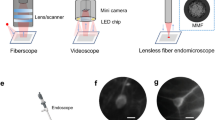Abstract
Laser-induced autofluorescence spectra from humans were recorded in vivo at three different clinics in a study aimed at investigating the capability of this method to discriminate between malignant tumours and normal surrounding tissues. For the recordings a mobile trolley with the necessary equipment was constructed for use in an examination room or in an operating theatre environment. Laser light was guided through a 600μm optical fibre to the target tissue. The fluorescence from the excited tissue was collected with the same fibre and was fed to an optical multichannel analyser. Two excitation wavelengths were used (337 and 405 nm) in order to optimize the fluorescence signals in two interesting wavelength regions (380–500 and 550–700 nm). Oral and oropharyngeal tumours excited with 405 nm light contained detectable endogenous porphyrins and were in this way discriminated from the normal mucosa. Astrocytoma grade III–IV fluorescence different from that of normal brain tissue, while tumours in the bronchial tree were not detectable using the spectral shape of the pure tissue autofluorescence.
Similar content being viewed by others
References
Cortese DA, Kinsey JH, Woolner LB et al. Hematoporphyrin derivative in the detection and localization of radiographically occult lung cancer.Am Rev Respir Dis 1982,126:1087–8
Profio AE, Doiron DR, Balchum OJ, Huth GC. Fluorescence bronchoscopy for localization of carcinoma in situ.Med Phys 1983,10:35–9
Kato H, Aizawa K, Ono J et al. Clinical measurement of tumor fluorescence using a new diagnostic system with hematoporphyrin derivative, laser photoradiation, and a spectroscope.Lasers Surg Med 1984,4:49–58
Kelly JF, Snell ME. Hematoporphyrin derivative: a possible aid in the diagnosis and therapy of carcinoma of the bladder.J Urol 1976,115:150–1
Spikes JD. Phthalocyanines as photosensitizers in biological systems and for photodynamic therapy of tumours.Photochem Photobiol 1986,43:691–9
Nelson JS, Roberts WG, Berns MW.In vivo studies on the utilization of mono-L-aspartyl chlorin (NPe6) for photodynamic therapy.Cancer Res 1987,47:4681–5
Lai JJ, McCaul BW, Smith KM, Straight RC. Polyhematoporphyrin esters: Preparation, properties and biological activity of a new stable derivative of hematoporphyrin for photodynamic therapy. In: Gomer CJ (ed)Proceedings of Clayton Foundation Conference on Photodynamic Therapy. Los Angeles, CA, 1987.
Andersson-Engels S, Ankerst J, Johansson J et al. Tumour marking properties of different haematoporphyrins and tetrasulphonated phthalocyanine—a comparison.Lasers Med Sci 1989,4:115–23
Svanberg K, Kjellén E, Ankerst J et al. Fluorescence studies of hematoporphyrin derivative in normal and malignant rat tissue.Cancer Res 1986,46:3803–8
Ye Yanming, Yang Yuanlong, Li Yufen et al. Characteristic autofluorescence for cancer diagnosis and the exploration of its origin. Conference on Lasers and Electro-Optics CLEO'85 Technical Digest, Baltimore, 1985:84
Ma Baozhang, Ye Yanming, Yang Yuanlong. Autofluorescence in laser diagnostics. International Conference on Photodynamic Therapy and Medical Applications of Lasers, London.Lasers Med Sci (Abstracts) July 1988, no. 7
Alfano RR, Darayash BT, Cordero J et al. Laser induced fluorescence spectroscopy from native cancerous and normal tissue.IEEE J Quantum Electron 1984,QE-20:1507–11
Andersson PS, Kjellén E, Montán S et al. Autofluorescence of various rodent tissues and human skin tumour samples.Lasers Med Sci 1987,2:41–9
Kato H, Cortese DA. Early detection of lung cancer by means of hematoporphyrin derivative fluorescence and laser photoradiation.Clinics Chest Med 1985,6:237–53
Kittrell C, Willett RL, de los Santos-Pacheo C et al. Diagnosis of fibrous arterial atherosclerosis using fluorescence.Appl Opt 1985,24:2280–1
Richards-Kortum RR, Metha A, Kolubayev T et al. Spectroscopic diagnosis for control of laser treatment of atherosclerosis. In: Persson W, Svanberg S (eds)Laser Spectroscopy VIII. Springer Series in Optical Science, Berlin, 1987:366–9
Oraevsky AA, Letokhov VS, Omelyanenko VG et al. Laser spectral analysis of human atherosclerotic vessels. In: Persson W, Svanberg S (eds)Laser Spectroscopy VIII. Springer Series in Optical Science, Berlin, 1987:370–1
Andersson PS, Gustafson A, Stenram U et al. Diagnosis of arterial atherosclerosis using laser-induced fluorescence.Lasers Med Sci 1987,2:261–6
Andersson-Engels S, Gustafson A, Johansson J et al. Laser-induced fluorescence used in localizing atherosclerotic lesions.Lasers Med Sci 1989,4:171–81
Alfano RR, Lam W, Jarrabi HJ et al. Human teeth with and without caries studied by laser scattering, fluorescence and absorption spectroscopy.IEEE J Quantum Electron 1984,QE-20:1512–6
Sundström F, Fredriksson K, Montán S et al. Laserinduced fluorescence from sound and carious tooth substance: spectroscopic studies.Swed Dent J 1985,9:71–80
Andersson-Engels S, Ankerst J, Montán S et al. Aspects of tumour demarcation in rats by means of laser-induced fluorescence and haematoporphyrin derivatives.Lasers Med Sci 1988,3:239–48
Svaasand LO, Ellingsen R. Optical properties of human brain.Photochem Photobiol 1983,38:293–9
Svaasand LO, Ellingsen R. Optical penetration in human intracranial tumors.Photochem Photobiol 1985,41:73–6
Balchum OJ, Profio AE, Razum N. Ratioing fluorometer probe for localizing carcinoma in situ in bronchi of the lung.Photochem Photobiol 1987,46:887–91
Author information
Authors and Affiliations
Rights and permissions
About this article
Cite this article
Andersson-Engels, S., Elner, Å., Johansson, J. et al. Clinical recording of laser-induced fluorescence spectra for evaluation of tumour demarcation feasibility in selected clinical specialities. Laser Med Sci 6, 415–424 (1991). https://doi.org/10.1007/BF02042464
Received:
Accepted:
Issue Date:
DOI: https://doi.org/10.1007/BF02042464




